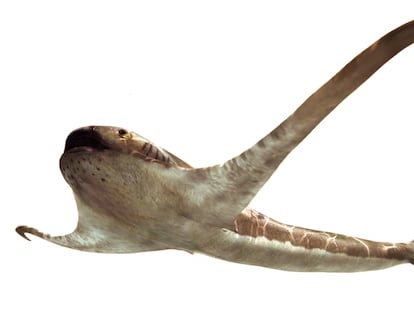‘Tyrannosaurus rex’ walked at same speed as humans, new study shows
The feared dinosaur had a natural walking pace of 4.6 kilometers per hour, according to an analysis that for the first time has taken into account the role of the carnivore’s tail

The Tyrannosaurus rex is the best-known predator of the prehistoric world. It measured 12 meters long, stood four meters tall up to the head and could weigh between 6,000 and 9,000 kilos. But this feared and powerful carnivore had a preferred walking speed of 4.6 kilometers per hour, a rate similar to that of humans. That’s according to new research by a team of scientists in the Netherlands and published on Wednesday in the Royal Society Open Science.
To reach this conclusion, the researchers did not focus on the feet or the hips of the theropod, who roamed the Earth during the Cretaceous period, but rather on the role of its tail. Although earlier studies had analyzed the movement of the Tyrannosaurus rex when it wasn’t running or hunting, they did not highlight the action of the tail in their calculations – even though it accounts for more than half the dinosaur’s body weight and can weigh as much as 1,000 kilos.
Animals and people save energy by walking at a regular pace. Humans reach the right walking speed for our bodies using our legs and the rhythmic swinging of our arms. The Tyrannosaurus rex had very short front limbs, very long hind limbs and a powerful tail with vertebrae and ligaments that allowed it to store and release energy by swaying it from side to side. “When the tail’s compass achieves resonance, in other words, the greatest movement with the lowest effort, we can talk about natural frequency. In this case, that would be when the animal is walking leisurely,” says Pasha van Bijlert, 27, the lead author of the investigation and a Master’s degree student at Vrije Universiteit in Amsterdam who is analyzing the locomotion of dinosaurs.
The walking speed of the ‘Tyrannosaurus rex’ was similar to that of other two and four-footed animals, like elephants and ostrichesPasha van Bijlert, lead author of study
To study the dinosaur’s movement, the researchers created a three-dimensional digital model of a Tyrannosaurus rex skeleton. This model was based on the skeleton of a 12-meter long female nicknamed Trix, whose 66-million-year-old remains were excavated – almost in their entirety – in the United States in 2013. The researchers then added the muscle and ligaments around the tail vertebrae, which are flexible and resistant to traction and compression. In order to understand the role of the tail in locomotion, the team subjected the musculoskeletal model to a series of biomechanical tests. “The balance of the tail is thanks to the ligaments that acted as a counterweight,” explains Van Bijlert. “It’s comparable to the suspension of a bridge, and produced some of the force needed to rhythmically push the body forward towards the front limbs. The speed of the steps had to correspond to natural frequency with the rise and fall of the tail, and we show that the Tyrannosaurus rex walked 1.28 meters per second.”
To calculate the dinosaur’s speed, the researchers also had to determine its stride, i.e. how much distance is covered with each step. To do this, the team digitally scaled a large tyrannosaurid trackway to determine a step length of 1.94 meters. “Combining both figures in all of our calculations, we estimate that it walked 4.6 kilometers an hour, more or less like a person,” says Van Bijlert, who adds that the calculations made by other experts on the dinosaur’s movement based on the height of its hip and the length of its legs were also key to analyzing its walking speed. “According to our interpretation, focusing on the tail can also help the results,” he says. Although the walking speed of the Tyrannosaurus rex was relatively slow, Van Bijlert points out that it is “similar to that of other two and four-footed animals, like elephants and ostriches.”
The team determined that the dinosaur has a stride of 1.94 meters
The study also counted on the participation of the Naturalis Biodiversity Center in Leiden in The Netherlands, where the skeleton used for the team’s biomechanical model is on display, as well as Utrecht University and Vrije Universiteit. The new research has had an immediate impact on the academic world. John Hutchinson, professor of evolutionary biomechanics at the Royal Veterinary College of London, responded that the role of the tail in these types of studies had been overlooked until now – a “very promising” message, says Van Bijlert, who stopped studying medicine when he realized that what really interested him were dinosaurs. As there is no paleontology degree available in Leiden, the 27-year-old decided to study dinosaurs in the movement sciences faculty. Van Bijlert says his passion for dinosaurs goes way back, and admits to seeing the 1993 blockbuster Jurassic Park “dozens of times.”
The researcher has calculated the preferred walking speed of the Tyrannosaurus rex, but does he know how fast it could run? Van Bijlert estimates that this was around 30 kilometers per hour, but says that studies put it between 20 and 30 km. “Some even argue it was faster, but if this was the case they could have broken their legs,” he says, adding that he would like to study the issue in the future. For now, studies show that the Tyrannosaurus rex, while huge and terrifying, was not as fast as the one racing after humans in Jurassic Park. As Van Bijlert puts it: “They exaggerate the speed of their Tyrannosaurus rex, but it’s a fun recreation.”
English version by Melissa Kitson.
Tu suscripción se está usando en otro dispositivo
¿Quieres añadir otro usuario a tu suscripción?
Si continúas leyendo en este dispositivo, no se podrá leer en el otro.
FlechaTu suscripción se está usando en otro dispositivo y solo puedes acceder a EL PAÍS desde un dispositivo a la vez.
Si quieres compartir tu cuenta, cambia tu suscripción a la modalidad Premium, así podrás añadir otro usuario. Cada uno accederá con su propia cuenta de email, lo que os permitirá personalizar vuestra experiencia en EL PAÍS.
¿Tienes una suscripción de empresa? Accede aquí para contratar más cuentas.
En el caso de no saber quién está usando tu cuenta, te recomendamos cambiar tu contraseña aquí.
Si decides continuar compartiendo tu cuenta, este mensaje se mostrará en tu dispositivo y en el de la otra persona que está usando tu cuenta de forma indefinida, afectando a tu experiencia de lectura. Puedes consultar aquí los términos y condiciones de la suscripción digital.
More information
Archived In
Últimas noticias
Most viewed
- Pablo Escobar’s hippos: A serious environmental problem, 40 years on
- Reinhard Genzel, Nobel laureate in physics: ‘One-minute videos will never give you the truth’
- Why we lost the habit of sleeping in two segments and how that changed our sense of time
- Charles Dubouloz, mountaineering star, retires at 36 with a farewell tour inspired by Walter Bonatti
- The Florida Keys tourist paradise is besieged by immigration agents: ‘We’ve never seen anything like this’











































